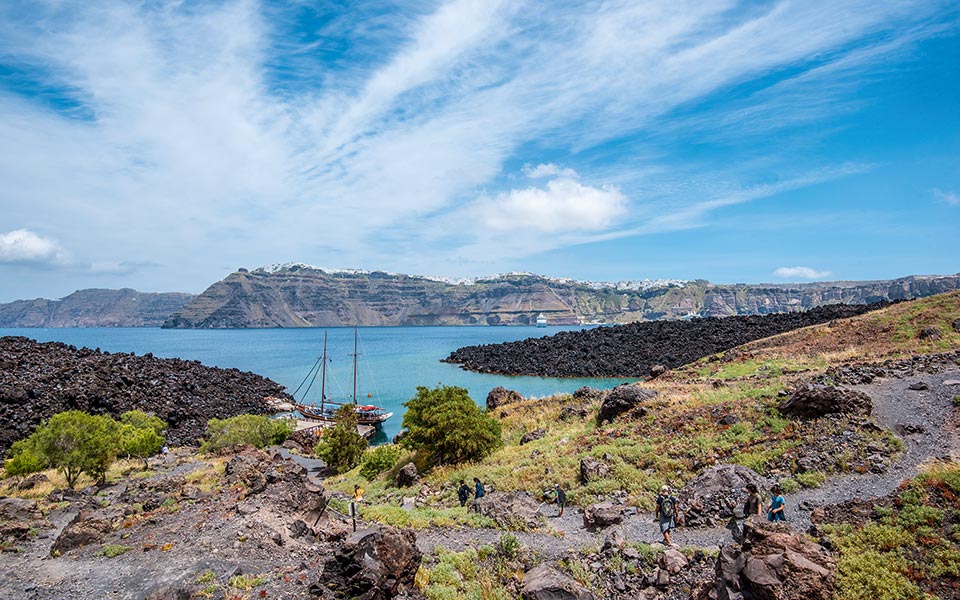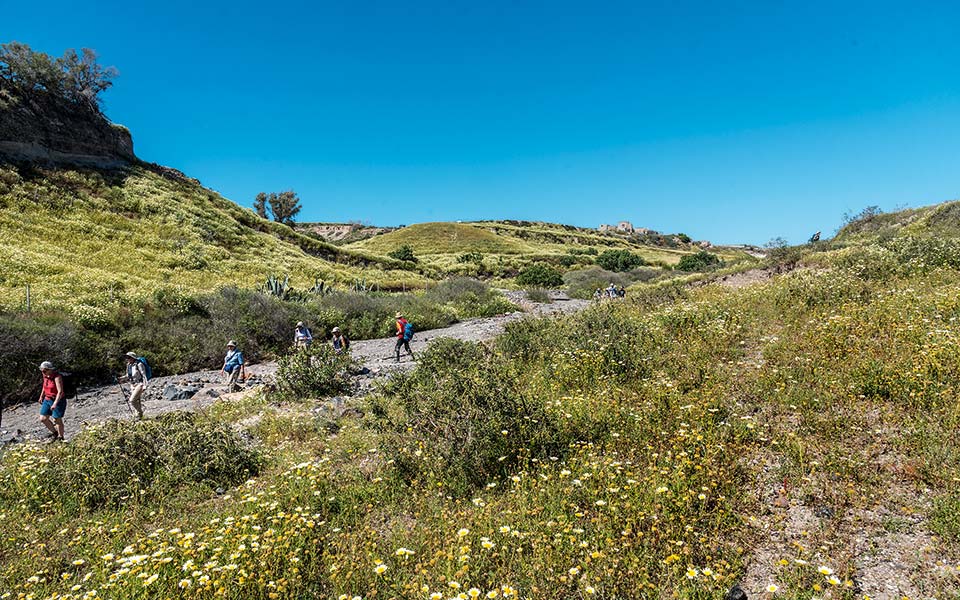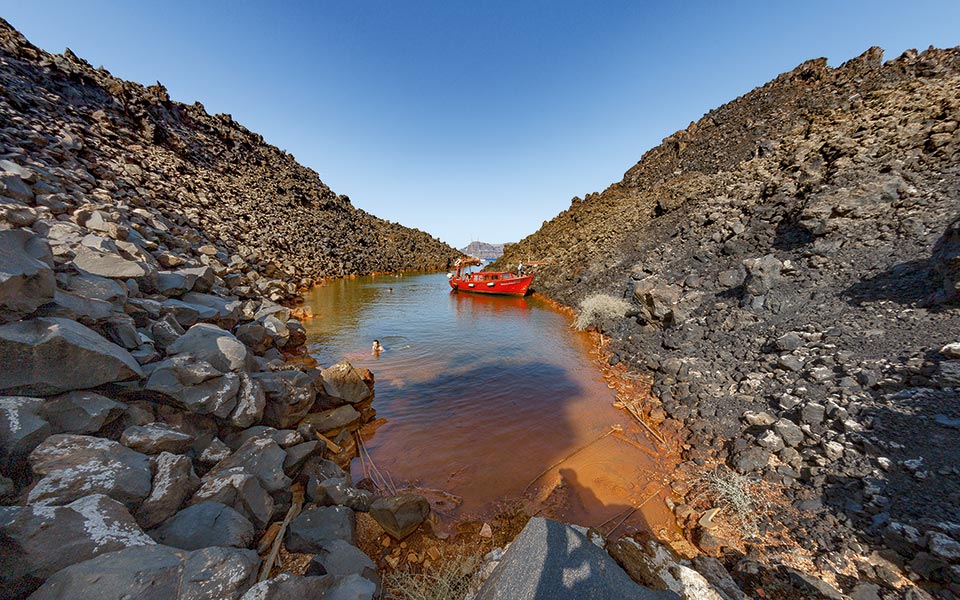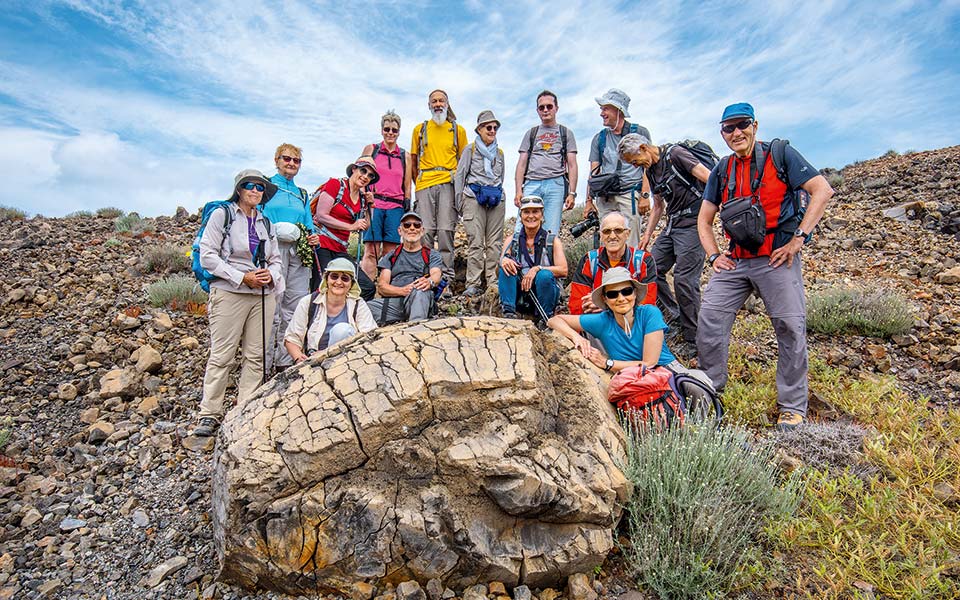by Tom Pfeiffer as told to Maria Coveou
I’ve always been fascinated by the forces of nature; storms, fires, big waves, volcanos. When I was five, my great-aunt showed me a picture book of the world and I remember being transfixed by a certain picture of the Stromboli volcano erupting at night. Little did I know then that, many years later in 1994, I’d be experiencing Stromboli erupting in person. Or that many years after that, I’d be organizing tours to another active, though dormant, volcano in neighboring Greece.
Becoming a volcanologist wasn’t something that I’d planned; it was the result of a series of happy coincidences, the first of which led me to Santorini in 1997 to replace a guide who was doing geological tours for German tourists. Santorini in the late 1990s was already quite touristy, and I kept meeting people (both tourists and locals) who had been familiar with the island for a long time and were complaining that it had changed a lot. “You should have been here 20 years ago,” they’d say.
Nowadays, I’d tell you the same thing, but back then everything was new and impressive. There were stylish villas, luxurious shops and exciting nightclubs; there was also a still relatively unspoiled countryside with hospitable villagers and, of course, a landscape that could tell you more about geology and volcanos than any textbook ever could.
In this open-air museum of volcanology, I met my future mentor and tutor, geologist Walter Ludwig Friedrich, who was conducting research on the Santorini volcano and who, before leaving the island, invited me to join his team. I quit my (not-so-exciting) studies in mineralogy at the University of Kiel in Germany and enrolled in the Department of Geology at the University of Aarhus in Denmark, where he was teaching.

© Tom Pfeiffer
The more I got into my new study subject, the more fascinating I found Santorini. This island witnessed one of the most significant natural events of the Bronze Age – an eruption that ranks as one of the largest during the past 10,000 years or so, and that is believed to have played a role in the demise of the most advanced civilization of the time, that of the Minoans.
This was the eruption that I decided to do my thesis on, so I started visiting Santorini to collect samples and take measurements. It was in 2002, during such a visit, that I came across a 3,600-year-old olive tree that had been buried alive in the pumice deposit. A branch from this tree has allowed the most precise dating so far of what’s called the Minoan Eruption, to 1613 BC (+/- 13 years).
Today, after countless visits to the island, I can say that, in some ways, I know it better than many locals. Perhaps that’s why I feel confident in showing people around, as if it were my home. And it is my home, in a sense, even though I don’t feel the same connection to the locals today as I did at first. I think overtourism has changed people; so many are focused on making money nowadays. I, on the other hand, am still the same volcano freak who likes to tell stories about how this volcanic island came into being. And it may seem surprising, but there are quite a few travelers from all over the world willing to listen to my stories and join me on my tours around the island.

© Tom Pfeiffer
My groups are always small and the participants are usually in their 50s. Though all of them are interested in learning, they don’t necessarily have a prior interest in volcanology; most are simply looking for an alternative vacation that involves something more than just lying on a beach.
Of course, they’re only human, so I’ll also show them to the non-volcanic areas of the island (Pyrgos, Profitis Ilias, Mesa Vouno) and take them on scenic hikes of the caldera for photos, and to beautiful Perissa Beach for a swim. I’ll go out with them for dinners, drinks and socializing, too. Still, I’m mostly interested in showing them that there’s more to the island than luxurious villas, epic sunsets and congested streets. So, in the spring, I’ll take them to areas covered in poppies and daisies, and down paths where you can hike for hours without encountering others. And, of course, I’ll take them to Akrotiri, to the caldera and to Palia Kameni and Nea Kameni to show them how Santorini “writes” its history on its rocks, on the pottery still trapped in its soil, on its craters, and on its cliffs.
Like most travelers, my clients, too, come with preconceptions. I think they leave, though, understanding you can only get to know the real island by approaching it like a new acquaintance: with an open mind and empathy. You might then hear its truth, about a dormant volcano which may seem harmless but is actually capable of great destruction. And while this isn’t cause for present alarm, it is cause for awe and great respect.

© Tobias Schorr
Personal Highlights
1. The caldera cliffs near Megalochori and Athinios. Although not the highest, they show the most amazing and varied succession of impressive volcanic layers draped over the old non-volcanic basement of the island: an open picture book to read the life story of Santorini!
2. The small bay of Balos near the village of Akrotiri. The area is particularly interesting, as it’s likely that it was already being used as a harbor in Minoan times. The first houses from the Bronze Age were discovered in this area in the early 19th century, but the findings are now lost. Today, you can observe an ancient exposed cinder cone and spectacular volcanic layers. It’s also one of the best places for swimming or just taking photographs.
3. The traditional houses in the middle of old villages like Pyrgos or Emporio. I can’t help but admire their layout and their appearance, the alternating straight and curved lines, and how they can be both functional and in harmony with their surroundings. The aesthetic result is quite unique to Santorini, like the singular style of a painter.
4. Sitting at the seaside on Akrotiri Beach during the blue hour, the sea spray reaching you while you’re eating grilled fish accompanied by simple house wine flavored by the old barrel in which it was aged.
5. The archaeological excavation of Akrotiri, which has unearthed a part of an impressive town about 4,000 years old. It’s certainly one of Europe’s most important archeological sites. It is in many ways similar to Italy’s well-known Pompeii (covered and destroyed by the ashes of Vesuvius volcano in AD 79) but it’s almost twice as old. I highly recommend visiting the place in the afternoon, when it’s normally quieter, and taking one of the excellent official guided tours for your first visit. An amazing world will come into view if you can see through the dust covering the stones.











